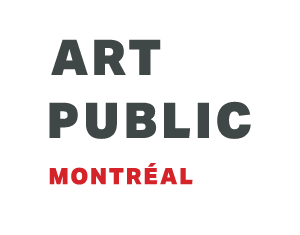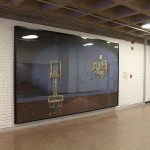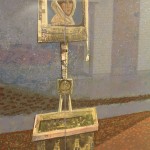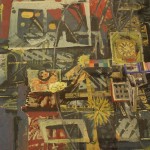





Jesus Carlos de Vilallonga grew up a culturally rich environment. In 1949, he moved to Barcelona and took classes at the San Jordi School of Fine Arts for three years. He then pursued his studies at the École des beaux-arts de Paris where he learned to master several artistic techniques ranging from watercolors to fresco. Upon his return to Barcelona, he was awarded first place for watercolors at the 1953 Spring Exhibition.
Vilallonga didn’t stray far from his native region of Catalonia’s great plastic arts tradition: the Dau al Set group, Gaudi and Roman frescos. He quickly adopted a style that was clearly influenced by fauvism, German expressionism and surrealism at the beginning of his career.
At the start of the 1950s, Vilallonga frequently stayed in Montreal and permeated the artistic community. He often visited Roussil, Vaillancourt, Molinari and Mousseau. He also met up with Jordi Bonet, his Barcelonian neighbour, who had also just arrived in Quebec. He explored urban themes, whilst still distancing himself from reality.
In the 1960s, Vilallonga was a surrealistic artist who employed chance in his collages. He believes in the liberating power of our imagination and is inspired by dreams and fantasy. He juxtaposes the extraordinary and everyday life. He also believes that Man can embellish the world by dreaming of it. Sometimes, the artist masters the composition of a given piece, but other times the piece’s meaning escapes him and the shapes take control of him. The pieces become purely symbolical and allegorical, offering multiple possible interpretations.
In 1958, the artist signed an exclusivity contract with the prestigious Galerie Dominion in Montreal, a contract that would only be nullified when the establishment shut down in 2000. Throughout his career, he traveled back and forth to Europe many times from Montreal either to work or study. This internationally renowned painter now lives in Catalonia.
Translated by Oliver Marshall.


Artwork description
Two hybrid objects float on a desertic, almost lunar-looking landscape which is created by small touches of colors. A road seems to cross a red and brown desert towards the horizon. The road, the sky and the dark cloud are also created with polychromatic touches, creating relief.
A woman’s portrait within a frame sits atop an antique marble basin on the left. The frame is an assembly of cuts from a newspaper whereas the basin is composed of upside-down glued fragments of pictures of Gothic cathedrals with added oil paint touches. A floating object composed of magazine pictures and photos – again with added touches of paint – floats on the right side of the piece.
The artist combines oil painting and a collage of different forms and shapes of paper on large Masonite boards. He schematically divided the background into two areas, one for the sky and one for the ground. The whole suggests an oniric and enigmatic universe, which is representative of the artist’s work.
This huge painting was first used for a theatrical play by the students in the Université de Montréal’s Spanish program in the 1960s. Vilallonga taught Spanish at the time and also created the set for students shows. However, the piece is representative of the artist’s method and deserves to be considered as a masterpiece in itself. Iconographic elements cherished by the artist throughout his career are juxtaposed on an almost abstract background. The feminine presence and the surrealist objects, for example. The scenes he paints are either symbolic or allegorical. As he said, he paints not what we see but what we do not want to see.
Vilallonga explained his approach in an interview: ”A white background doesn’t inspire me in the least bit. I fill it with all sorts of colors with my brush, my spatula or my knife. I project them from above or I let them flow. Sometimes, I glue bits of tissue that I colored beforehand. When my canvas is entirely covered in striations, spots, drips, I attentively study it, and from the form and the color, or from a marriage of colors, the inspiration will born.” [Loose translation]



